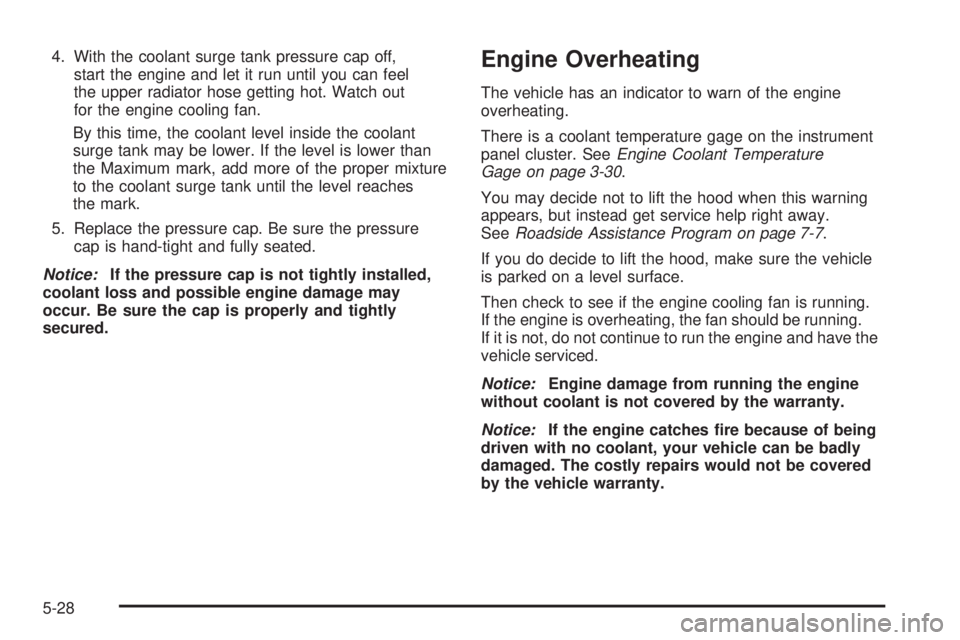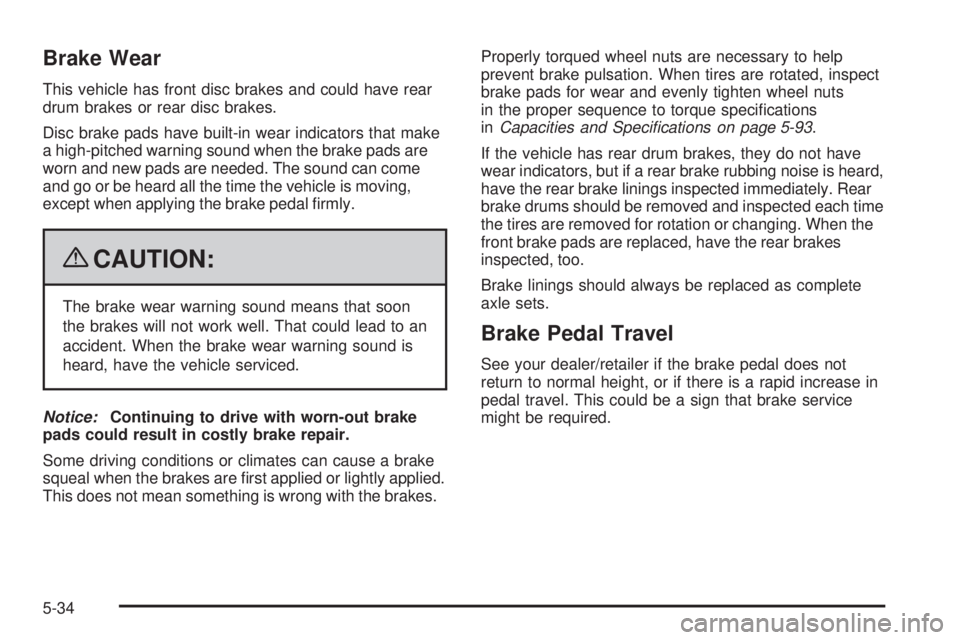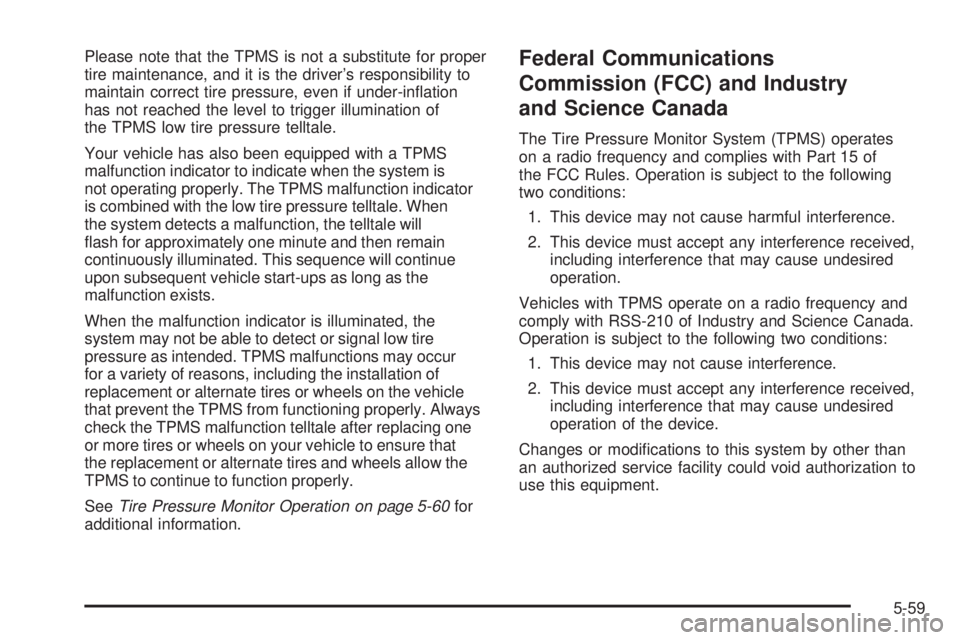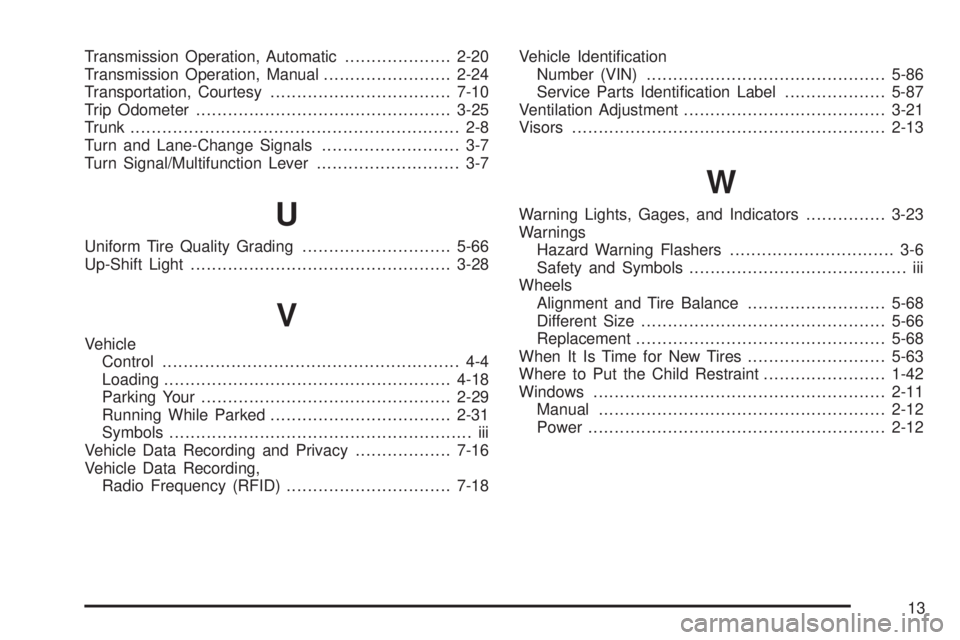service indicator PONTIAC G3 2009 User Guide
[x] Cancel search | Manufacturer: PONTIAC, Model Year: 2009, Model line: G3, Model: PONTIAC G3 2009Pages: 348, PDF Size: 2.16 MB
Page 232 of 348

4. With the coolant surge tank pressure cap off,
start the engine and let it run until you can feel
the upper radiator hose getting hot. Watch out
for the engine cooling fan.
By this time, the coolant level inside the coolant
surge tank may be lower. If the level is lower than
the Maximum mark, add more of the proper mixture
to the coolant surge tank until the level reaches
the mark.
5. Replace the pressure cap. Be sure the pressure
cap is hand-tight and fully seated.
Notice:If the pressure cap is not tightly installed,
coolant loss and possible engine damage may
occur. Be sure the cap is properly and tightly
secured.Engine Overheating
The vehicle has an indicator to warn of the engine
overheating.
There is a coolant temperature gage on the instrument
panel cluster. SeeEngine Coolant Temperature
Gage on page 3-30.
You may decide not to lift the hood when this warning
appears, but instead get service help right away.
SeeRoadside Assistance Program on page 7-7.
If you do decide to lift the hood, make sure the vehicle
is parked on a level surface.
Then check to see if the engine cooling fan is running.
If the engine is overheating, the fan should be running.
If it is not, do not continue to run the engine and have the
vehicle serviced.
Notice:Engine damage from running the engine
without coolant is not covered by the warranty.
Notice:If the engine catches �re because of being
driven with no coolant, your vehicle can be badly
damaged. The costly repairs would not be covered
by the vehicle warranty.
5-28
Page 238 of 348

Brake Wear
This vehicle has front disc brakes and could have rear
drum brakes or rear disc brakes.
Disc brake pads have built-in wear indicators that make
a high-pitched warning sound when the brake pads are
worn and new pads are needed. The sound can come
and go or be heard all the time the vehicle is moving,
except when applying the brake pedal �rmly.
{CAUTION:
The brake wear warning sound means that soon
the brakes will not work well. That could lead to an
accident. When the brake wear warning sound is
heard, have the vehicle serviced.
Notice:Continuing to drive with worn-out brake
pads could result in costly brake repair.
Some driving conditions or climates can cause a brake
squeal when the brakes are �rst applied or lightly applied.
This does not mean something is wrong with the brakes.Properly torqued wheel nuts are necessary to help
prevent brake pulsation. When tires are rotated, inspect
brake pads for wear and evenly tighten wheel nuts
in the proper sequence to torque speci�cations
inCapacities and Specifications on page 5-93.
If the vehicle has rear drum brakes, they do not have
wear indicators, but if a rear brake rubbing noise is heard,
have the rear brake linings inspected immediately. Rear
brake drums should be removed and inspected each time
the tires are removed for rotation or changing. When the
front brake pads are replaced, have the rear brakes
inspected, too.
Brake linings should always be replaced as complete
axle sets.
Brake Pedal Travel
See your dealer/retailer if the brake pedal does not
return to normal height, or if there is a rapid increase in
pedal travel. This could be a sign that brake service
might be required.
5-34
Page 263 of 348

Please note that the TPMS is not a substitute for proper
tire maintenance, and it is the driver’s responsibility to
maintain correct tire pressure, even if under-in�ation
has not reached the level to trigger illumination of
the TPMS low tire pressure telltale.
Your vehicle has also been equipped with a TPMS
malfunction indicator to indicate when the system is
not operating properly. The TPMS malfunction indicator
is combined with the low tire pressure telltale. When
the system detects a malfunction, the telltale will
�ash for approximately one minute and then remain
continuously illuminated. This sequence will continue
upon subsequent vehicle start-ups as long as the
malfunction exists.
When the malfunction indicator is illuminated, the
system may not be able to detect or signal low tire
pressure as intended. TPMS malfunctions may occur
for a variety of reasons, including the installation of
replacement or alternate tires or wheels on the vehicle
that prevent the TPMS from functioning properly. Always
check the TPMS malfunction telltale after replacing one
or more tires or wheels on your vehicle to ensure that
the replacement or alternate tires and wheels allow the
TPMS to continue to function properly.
SeeTire Pressure Monitor Operation on page 5-60for
additional information.Federal Communications
Commission (FCC) and Industry
and Science Canada
The Tire Pressure Monitor System (TPMS) operates
on a radio frequency and complies with Part 15 of
the FCC Rules. Operation is subject to the following
two conditions:
1. This device may not cause harmful interference.
2. This device must accept any interference received,
including interference that may cause undesired
operation.
Vehicles with TPMS operate on a radio frequency and
comply with RSS-210 of Industry and Science Canada.
Operation is subject to the following two conditions:
1. This device may not cause interference.
2. This device must accept any interference received,
including interference that may cause undesired
operation of the device.
Changes or modi�cations to this system by other than
an authorized service facility could void authorization to
use this equipment.
5-59
Page 335 of 348

A
Accessories and Modi�cations............................ 5-3
Accessory Power Outlets.................................3-16
Adding Equipment to Your Airbag-Equipped
Vehicle.......................................................1-71
Additional Required Services, Scheduled
Maintenance................................................. 6-6
Additives, Fuel................................................. 5-6
Add-On Electrical Equipment............................5-87
Air Cleaner/Filter, Engine.................................5-18
Air Conditioning..............................................3-18
Air Filter, Passenger Compartment....................3-22
Airbag
Readiness Light..........................................3-26
Airbag System................................................1-58
Adding Equipment to Your Airbag-Equipped
Vehicle...................................................1-71
How Does an Airbag Restrain?......................1-63
Passenger Sensing System...........................1-65
Servicing Your Airbag-Equipped Vehicle..........1-70
What Makes an Airbag In�ate?......................1-63
What Will You See After an Airbag In�ates?....1-64
When Should an Airbag In�ate?....................1-62
Where Are the Airbags?...............................1-60
Airbags
Passenger Status Indicator...........................3-27AM-FM Radio.................................................3-39
Antenna
Backglass...................................................3-56
Fixed Mast.................................................3-56
Antilock Brake System (ABS)............................. 4-5
Warning Light.............................................3-30
Appearance Care
Aluminum Wheels........................................5-84
Care of Safety Belts....................................5-82
Chemical Paint Spotting...............................5-86
Cleaning Exterior Lamps/Lenses....................5-83
Fabric/Carpet..............................................5-80
Finish Care.................................................5-83
Finish Damage............................................5-85
Glass Surfaces............................................
5-82
Instrument Panel, Vinyl, and Other
Plastic Surfaces.......................................5-81
Interior Cleaning..........................................5-79
Interior Plastic Components...........................5-81
Leather......................................................5-81
Sheet Metal Damage...................................5-85
Tires..........................................................5-85
Underbody Maintenance...............................5-86
Washing Your Vehicle...................................5-82
Weatherstrips..............................................5-82
Windshield and Wiper Blades........................5-84
Ashtray.........................................................3-17
1
Page 338 of 348

Cruise Control Light........................................3-36
Cupholders....................................................2-37
Customer Assistance......................................... 7-6
Offices......................................................... 7-6
Text Telephone (TTY) Users........................... 7-6
Customer Information
Service Publications Ordering Information........7-15
Customer Satisfaction Procedure........................ 7-2
D
Damage Repair, Collision.................................7-11
Data Recorders
Event.........................................................7-17
Daytime Running Lamps (DRL).........................3-14
Daytime Running Lamps Indicator Light.............3-36
Defensive Driving............................................. 4-2
Disc, MP3......................................................3-51
Doing Your Own Service Work........................... 5-4
Dome Lamp ...................................................3-15
Door
Ajar Light...................................................3-36
Ajar Reminder.............................................. 2-7
Central Door Unlocking System....................... 2-6
Locks.......................................................... 2-6
Rear Door Security Locks............................... 2-7Driver
Seat Height Adjuster...................................... 1-5
Driving
At Night.....................................................4-10
Before a Long Trip......................................4-12
Defensive..................................................... 4-2
Drunk.......................................................... 4-3
Highway Hypnosis.......................................4-12
Hill and Mountain Roads..............................4-13
In Rain and on Wet Roads...........................4-11
Loss of Control............................................. 4-8
Off-Road Recovery........................................ 4-8
Rocking Your Vehicle to Get it Out.................4-18
Winter........................................................4-14
Driving for Better Fuel Economy......................... 4-2
E
EDR .............................................................7-16
Electrical Equipment
Add-On Equipment......................................5-87
Electrical System
Engine Compartment Fuse Block...................5-90
Fuses and Circuit Breakers...........................5-88
Headlamp Wiring.........................................5-87
4
Page 342 of 348

Lights (cont.)
Low Fuel Warning.......................................3-37
Oil Pressure...............................................3-34
Passenger Airbag Status Indicator..................3-27
Safety Belt Reminders..................................3-26
Tire Pressure..............................................3-31
Up-Shift.....................................................3-28
Loading Your Vehicle.......................................4-18
Locks
Central Door Unlocking System....................... 2-6
Door ........................................................... 2-6
Rear Door Security Locks............................... 2-7
Loss of Control................................................ 4-8
Low Fuel Warning Light...................................3-37
Lower Anchors and Tethers for Children.............1-44
Lumbar
Manual Controls............................................ 1-5
M
Maintenance
Footnotes..................................................... 6-7
Maintenance Schedule
Additional Required Services........................... 6-6
At Each Fuel Fill........................................... 6-9
At Least Once a Month.................................. 6-9Maintenance Schedule (cont.)
At Least Once a Year..................................6-10
Maintenance Record....................................6-16
Maintenance Replacement Parts....................6-14
Maintenance Requirements............................. 6-2
Owner Checks and Services........................... 6-9
Recommended Fluids and Lubricants.............6-12
Scheduled Maintenance................................. 6-4
Using.......................................................... 6-3
Your Vehicle and the Environment................... 6-2
Malfunction Indicator Lamp...............................3-32
Manual Lumbar Controls.................................... 1-5
Manual Seats................................................... 1-4
Manual Transmission
Fluid..........................................................5-21
Operation...................................................2-24
Manual Windows............................................2-12
Mirrors
Manual Rearview Mirror................................2-32
Outside Convex Mirror.................................2-33
Outside Heated Mirrors................................2-33
Outside Manual Mirrors................................2-32
Outside Power Mirrors..................................2-33
MP3 .............................................................3-51
8
Page 343 of 348

N
Navigation System, Privacy..............................7-18
New Vehicle Break-In......................................2-16
O
Odometer......................................................3-25
Odometer, Trip...............................................3-25
Off-Road
Recovery..................................................... 4-8
Oil
Change Engine Oil Light...............................3-35
Engine.......................................................5-13
Engine Oil Life System.................................5-16
Pressure Light.............................................3-34
Older Children, Restraints................................1-32
Online Owner Center........................................ 7-5
OnStar, Privacy..............................................7-18
OnStar
®System, see OnStar®Manual...............2-34
Outlet Adjustment............................................3-21
Outlets
Accessory Power.........................................3-16Outside
Convex Mirror.............................................2-33
Heated Mirrors............................................2-33
Manual Mirrors............................................2-32
Power Mirrors.............................................2-33
Owner Checks and Services.............................. 6-9
Owners, Canadian............................................... ii
P
Paint, Damage...............................................5-85
Park
Shifting Into................................................2-27
Shifting Out of............................................2-28
Parking
Over Things That Burn.................................2-30
Parking Brake................................................2-26
Parking Your Vehicle.......................................2-29
Passenger Airbag Status Indicator.....................3-27
Passenger Compartment Air Filter.....................3-22
Passenger Sensing System..............................1-65
Passing........................................................... 4-8
Perchlorate Materials Requirements,
California..................................................... 5-4
9
Page 347 of 348

Transmission Operation, Automatic....................2-20
Transmission Operation, Manual........................2-24
Transportation, Courtesy..................................7-10
Trip Odometer................................................3-25
Trunk.............................................................. 2-8
Turn and Lane-Change Signals.......................... 3-7
Turn Signal/Multifunction Lever........................... 3-7
U
Uniform Tire Quality Grading............................5-66
Up-Shift Light.................................................3-28
V
Vehicle
Control........................................................ 4-4
Loading......................................................4-18
Parking Your...............................................2-29
Running While Parked..................................2-31
Symbols......................................................... iii
Vehicle Data Recording and Privacy..................7-16
Vehicle Data Recording,
Radio Frequency (RFID)...............................7-18Vehicle Identi�cation
Number (VIN).............................................5-86
Service Parts Identi�cation Label...................5-87
Ventilation Adjustment......................................3-21
Visors...........................................................2-13
W
Warning Lights, Gages, and Indicators...............3-23
Warnings
Hazard Warning Flashers............................... 3-6
Safety and Symbols......................................... iii
Wheels
Alignment and Tire Balance..........................5-68
Different Size..............................................5-66
Replacement...............................................5-68
When It Is Time for New Tires..........................5-63
Where to Put the Child Restraint.......................1-42
Windows.......................................................2-11
Manual......................................................2-12
Power ........................................................2-12
13